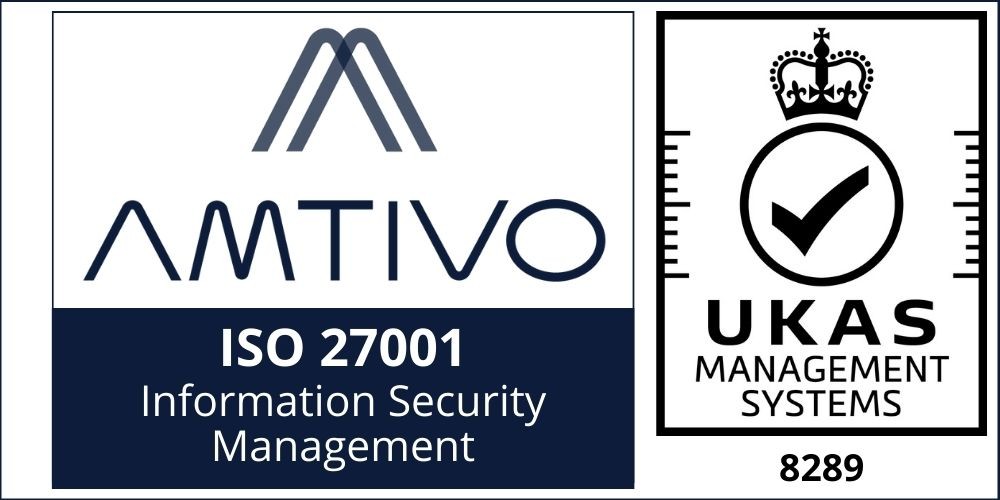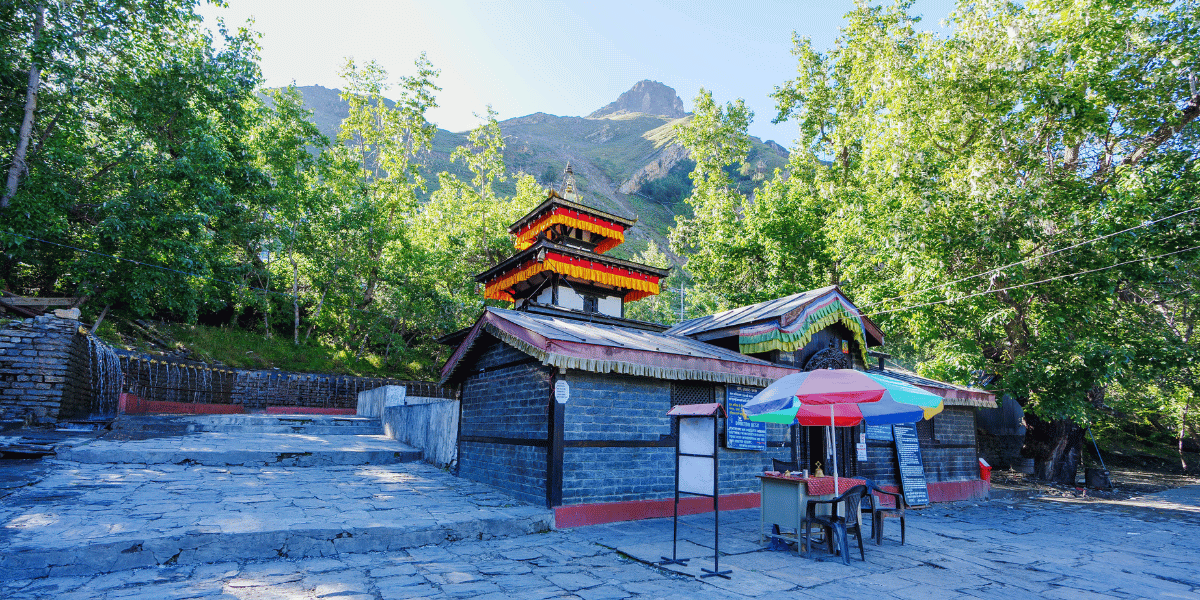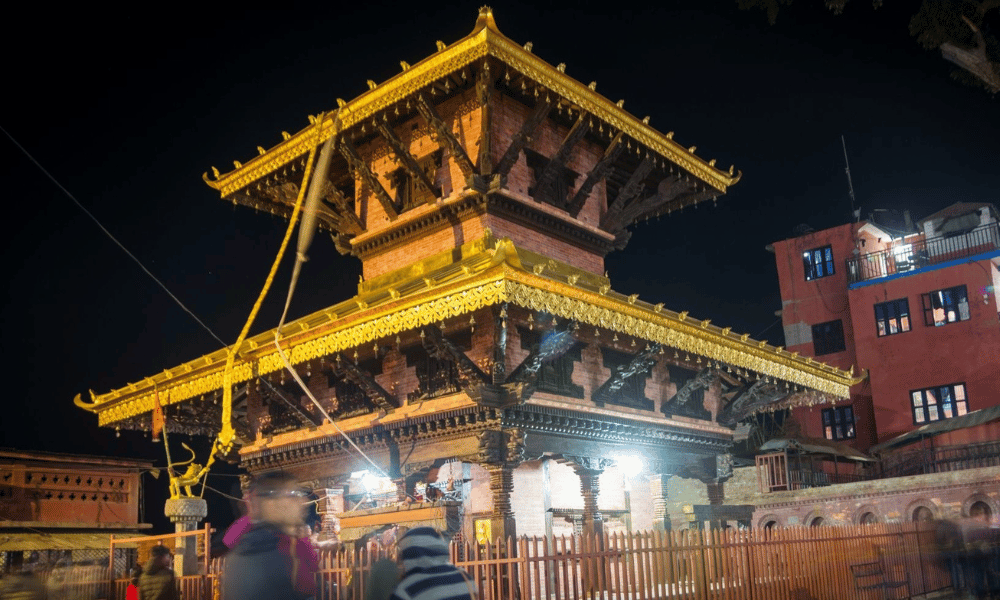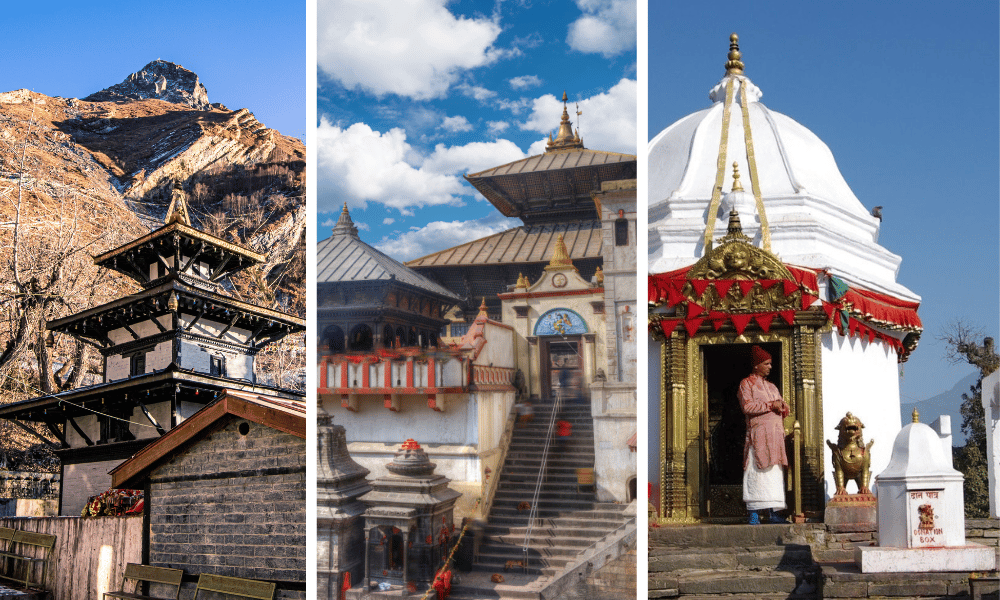The Pashupatinath Temple, dedicated to Lord Shiva and located on the banks of the holy Bagmati River in Kathmandu, Nepal, is a timeless spiritual and cultural symbol. The name "Pashupatinath" comes from the words "Pashu", which means "animal" or "living thing", and "Pati", which means "Lord" or "Master". As a result, the temple's name translates to "Lord of Animals" or "Lord of all living things", reflecting its significance in Hinduism as a holy place as a sacred abode of Lord Shiva.
The architectural masterpiece is designed in the Nepali pagoda style and is embellished with intricate carvings and beautiful decorations that highlight Nepal's rich historical and artistic history. People come from all over the world to visit this holy Hindu shrine and take part in rituals that have been practiced for generations. As one of the four most important religious sites in Asia and believed to be the world's biggest and oldest Shiva temple, Pashupatinath has a strong spiritual impact on many people.
Its status as a UNESCO World Heritage Site adds to its cultural and historical value. The site covers a large area of 246 hectares (2.56 KM square) and has 518 smaller shrines, ashrams, and ghats along the holy river. Additionally, it is the largest temple complex in all of Nepal. The temple complex is not only a great example of Nepalese architecture, but it also has other important temples that add to its beauty. The Vasuki Nath Temple, the Bhairav Nath Temple, and the Guhyeshwari Temple all add to the spiritual atmosphere, making it a place where religion, architecture, and custom all come together.
It's a unique and peaceful experience to sit or just be near Pashupatinath. A calming ambience is created by the rhythmic chants and rituals, while the air is filled with the aroma of incense. Whether one is a casual observer or a committed pilgrim, the surroundings convey a timeless spirituality that invites contemplation and reflection. There is a sense of tradition and dedication in the air around the temple that goes back hundreds of years. By soaking in the serene atmosphere, Pashupatinath transforms into a spiritual haven that goes beyond the ordinary, providing a unique opportunity for inner peace and connection with the divine. Let us take a closer look at the parts of this spiritually enlightened place.
Related Article: Pashupatinath Temple Photos
Table Of Content
- Pashupatinath Temple Facts
- History and Mythology
- Cultural And Religious Significance
- Priests of Pashupatinath Temple
- Major Attractions
- Major Festivals
- Pashupatinath Temple Daily Rituals
- Pashupatinath Temple Pujas Cost
- Best Time To Visit Pashupatinath Temple
- How to reach Pashupatinath Temple
- Things To Remember
- Frequently Asked Questions (FAQs)
Pashupatinath Temple Facts
Here are some facts related to Pashupatinath Temple:
|
Site |
Pashupatinath |
|
Affiliation |
Hinduism |
|
Deity |
Lord Shiva |
|
Location |
Gaushala, Kathmandu, Nepal |
|
Province |
Bagmati |
|
Total Area |
246 hectares (2.56 KM square) |
|
Established By |
Prachanda Deva (Renovated) |
|
UNESCO World Heritage Site Listed |
1979 AD |
|
Major Attractions |
|
|
Major Festivals |
|
|
Architecture Style |
|
|
Restrictions |
|
|
Opening Hours(Main Temple) |
04:00 AM - 12:00 PM 05:00 PM - 08:00 PM |
|
Entry Fee |
NRs 1000 for Foreigners (Free for Nepalese and Indians) |
History and Mythology
The Pashupatinath Temple, often regarded as Kathmandu's oldest temple, has a centuries-long history, dating back to the Licchavi dynasty in the 4th century. The temple complex, dedicated to Lord Shiva as Pashupati, is an example of Nepal's old architectural excellence. Its development was greatly aided by the Licchavi monarchs, who created a hallowed area that has since grown to be an essential component of Hinduism.
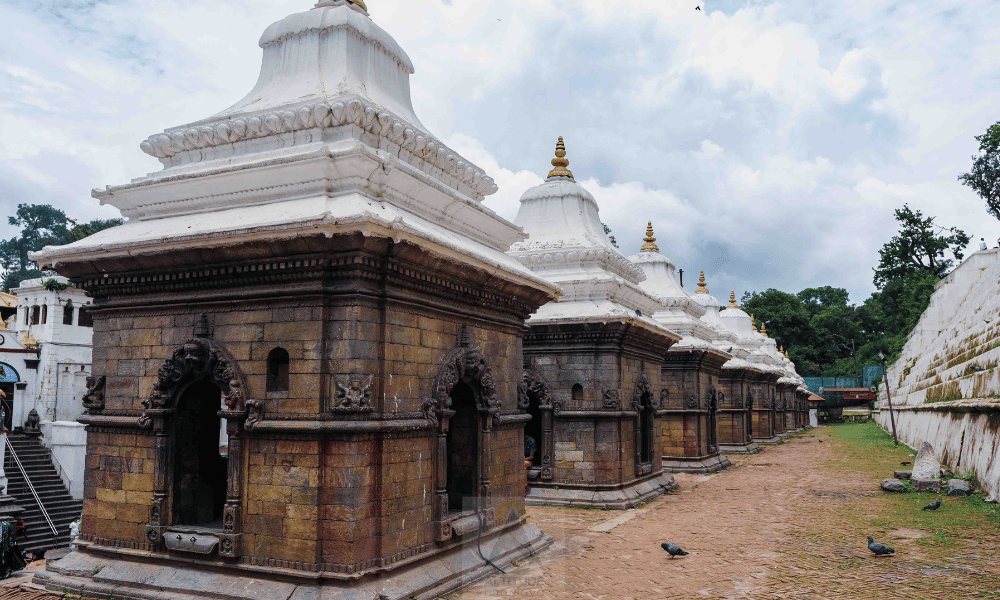
The esteemed status of Pashupatinath is not limited to historical records; it is mentioned in ancient Hindu writings such as the Puranas. There are numerous traditions that explain how the temple of Aalok Pashupatinath came to be here. According to one tale, gods frequently took the guise of animals and came to earth to rest from their cosmic tasks. On one such occasion, Lord Shiva and his consort Goddess Parvati appeared on Earth, at the location of Pashupatinath, now in the form of a deer. They were captivated with the location and wished to spend eternity there. Other gods, however, were displeased and arrived on Earth to convince Lord Shiva to return to his responsibilities. Lord Shiva refused to return to Kailash, sparking a war between him and the other gods. Due to the pressure, he eventually agreed to return. However, while fighting in his deer form, one of his antlers fell off and shattered into four pieces. That antler was considered to be the first Chaturmukha linga (Four Faced Linga) of Pashupatinath, which was worshiped by Lord Shiva followers. Tatpurusha (east face), Aghora (south face), Sadyojata (west face), and Vamadeva (north face) are the four faces of Chaturmukha linga.
The Lingham is reported to have vanished at some point in time, causing quite a commotion among the pilgrims. However, a cow was later witnessed pouring its milk to fertilize the ground around a specified area. It is also said that the cow did not produce milk at any other location or time of day. So people dug up that area to know the mystery and found the missing Lingam. To honor Lord Shiva and the Shivalinga, a tiny wooden temple was built around the Lingam.
Following the completion of the main temple, successive centuries witnessed the construction of additional temples within the Pashupatinath complex. According to legend, Pashupatinath Temple was originally a Linga-shaped Devalaya before Supuspa Deva built a five-story Pashupatinath temple in this location. The temple required to be restored and renovated throughout time. The modern Pashupatinath complex's main temple was built at the end of the 17th century to replace the previous one, which was damaged by termites. The Malla and Shah dynasties, among others, made substantial contributions to the site's expansion and adornment. The incorporation of several architectural styles, such as the pagoda and shikhara, symbolizes the Kathmandu Valley's developing cultural landscape.
The temple complex's construction and expansion went through several phases of renovation under various governing monarchs. The beautiful wood carvings, gold plating, and silver decoration demonstrate Nepalese craftsmanship's artistic quality. However, the tragic earthquake of 2015 caused damage on Pashupatinath and its surrounds, prompting substantial restoration operations. Following repairs targeted not only to repair structural damage but also to protect the spiritual sacredness of the monument, ensuring that Pashupatinath remains a beacon of cultural and religious significance in the heart of Nepal.
Cultural And Religious Significance
The Pashupatinath Temple, located in the heart of Kathmandu, is a must-visit Shiva temple and a sacred pilgrimage site in the Hindu faith worldwide. Pashupatinath draws both devotees and visitors because of its esteemed reputation as the "Lord of all living beings", capturing the essence of Lord Shiva's cosmic presence. The temple is a symbol of Hindu devotion, drawing pilgrims seeking divine blessings, spiritual comfort, and a link to ancient religious traditions.
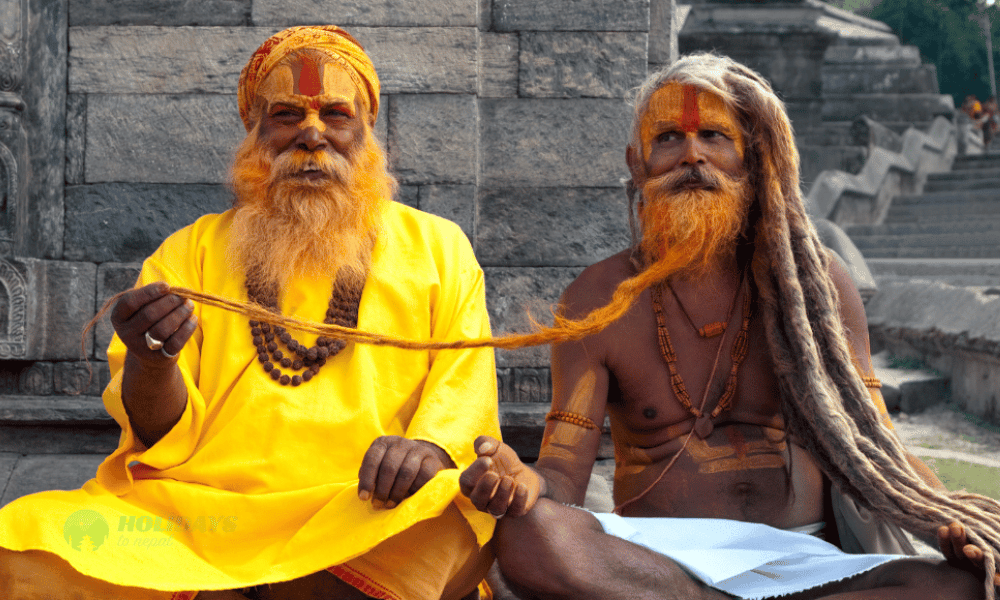
Culturally, Pashupatinath is a living testament to Nepalese workmanship, combining pagoda and shikhara architectural forms. The elaborate wood carvings, gold plating, and silver embellishments not only highlight the country's rich creative legacy, but they also serve as displays of devotion. The harmonious combination of architecture and symbolism results in a revered location where culture and spirituality meet. The temple's location near the Bagmati River adds to its cultural value, as the river is regarded as sacred and plays an important role in religious rites and rituals.
Pashupatinath is a significant site for a wide range of religious activities, from everyday rites to grand festivals. Devotees participate in events such as Rudrabhishek, in which offerings are presented to Lord Shiva, strengthening the temple's spiritual atmosphere. The temple complex, which includes other smaller shrines, ashrams, and ghats, functions as a multidimensional religious hub. The annual Maha Shivaratri festival, which draws thousands of pilgrims, showcases Pashupatinath's religious enthusiasm, transforming it into a vibrant hub for cultural and religious events.
The temple's cultural and religious value is further heightened by its designation as a UNESCO World legacy Site, highlighting its global significance as an archive of cultural wealth and spiritual legacy. The temple's fundamental connection to Hindu mythology, architectural splendor, and role as a focal point for religious activities all contribute to its unequaled cultural and religious significance.
Priests of Pashupatinath Temple
The priests of the Pashupatinath Temple, known as "Bhattas" or "Bhat", play an important role in preserving and perpetuating the temple's sacred traditions. These priests' history is intricately linked with the sacredness of Pashupatinath and dates back centuries. Only four priests are permitted to touch the idol. Pashupatinath's daily rites are performed by two sets of priests: the Bhatta and the Rajbhandari. Bhandaris are helpers and temple caretakers who are not qualified to perform puja rituals or touch the lingam, whereas Bhatta do the daily ritual and can touch the lingam. You may observe the Bhandaris accepting your offerings and bringing them to the Bhatta pujaris in the inner sanctum, who then offer them to the Lord.

Bhatta are Karnataka's highly educated Vedic Dravida Brahmin intellectuals. The priesthood of Pashupatinath, unlike that of other Hindu temples, is not hereditary. Priests are chosen from a group of scholars schooled in Rig Vedic recitation by Sri Sankaracharya Daksinamnaya Pitha, Sringeri, initiated in Pashupata Yoga, Shiva gama, and learned Samaveda recitation from Haridwar. After qualifying and meeting all of the conditions, they are chosen for priesthood by the Raj Guru of Pashupatinath Temple after a rigorous examination in Vedas and Shiva Agamas. The chosen priest is sent to Kathmandu to do Pashupatinath puja and daily worship. They are vital personnel in Pashupatinath, which is why police security is deployed to safeguard them at all times. The current head priest of Pashupatinath Temple is Guru Binaya Adiga-Bhatta.
The Rajbhandaris are the temple's treasures, temple caretakers, and assistant priests. They are the descendants of early Bhatt helper priests who were allowed to live in Kathmandu valley and were later incorporated into the existing Newar caste structure of Rajbhandari - a high-caste Chathariya/Kshatriya clan of Kashyapa gotra. Their primary responsibility is to assist the Bhatt priests and maintain the inner garbhagriha. They can have little or no Vedic knowledge and still qualify as assistant priests provided they are from the same family lineage and meet some basic requirements such as caste, gotra, lineage purity, and educational qualification. They operate in groups of three and alternate every full moon day.
The Pashupatinath priests' history is a tapestry woven with dedication, discipline, and a great sense of duty. Their presence is essential to the temple's dynamic spiritual ambience, assuring the continuation of age-old traditions and the smooth orchestration of religious practices. As torchbearers of the sacred flame that has burnt for generations in Pashupatinath, the Bhattas serve as living conduits between the earthly sphere and the divine, representing the temple's enduring tradition of dedication and service.
Major Attractions
Pashupatinath Temple complex beckons pilgrims and visitors alike, inviting them to explore a realm where ancient traditions, vibrant spirituality, and artistic brilliance converge. Within its confines, a series of major attractions await, each bearing witness to the enduring legacy of devotion and the rich tapestry of Nepal's cultural heritage.
Pashupatinath Temple
The Pashupatinath Temple is Nepal's most important Hindu pilgrimage site, captivating visitors with its profound cultural and spiritual significance. This temple, located within the huge Pashupatinath complex, is recognised not only for its religious significance but also for its architectural splendor. The two-tiered structure, which combines parts of a pagoda and a shikhara, is a remarkable feature that draws both devotees and tourists.

The temple's unique box architecture is embellished with four meticulously made enormous silver doors, creating an extravagant entrance that displays Nepalese workmanship. The copper and gold-covered roofs culminate in a brilliant gold pinnacle that gleams in the sunlight. The temple's structural stability is supported by robust wood beams, a monument to the architectural skill of the craftsmen who built this sacred temple.
A statue of Nandi, the sacred bull and devoted companion of Lord Shiva, guards the entrance to the main shrine. The main temple is divided into two garbhagrihas: the innermost chamber, which houses the principal deity, and an exterior corridor-like room. The Chaturmukha Linga (Four Faced Linga) is located in the inner sanctuary and is a symbolic image of Lord Shiva's divine creative energy, inspiring a profound sense of spiritual connection for the devotees.
The Pashupatinath Temple is an important part of Nepal's history, encompassing centuries of religious practices and traditions. Its architectural magnificence, decorated with religious symbols and housing a treasured lingam, illustrates the region's deeply established spiritual fabric. Pashupatinath, as a pilgrimage and prayer site, continues to serve as a living witness to Nepal's cultural and religious richness, attracting people from all walks of life to experience its timeless aura.
Gorakhnath Temple
The Gorakhnath Temple, located on the Pashupatinath hilltop, is a testimony to the Nath sect of yogis and their respected guru, Gorakhnath. The temple is an important part of the region's spiritual environment. Gorakhnath, a famous yogi and sage and one of Guru Matsyendranath's two notable students, played a crucial role in spreading the Nath tradition and is credited with imparting vital yoga and spiritual teachings. The shrine dedicated to him is a symbol of the spiritual inheritance of the Nath sect.
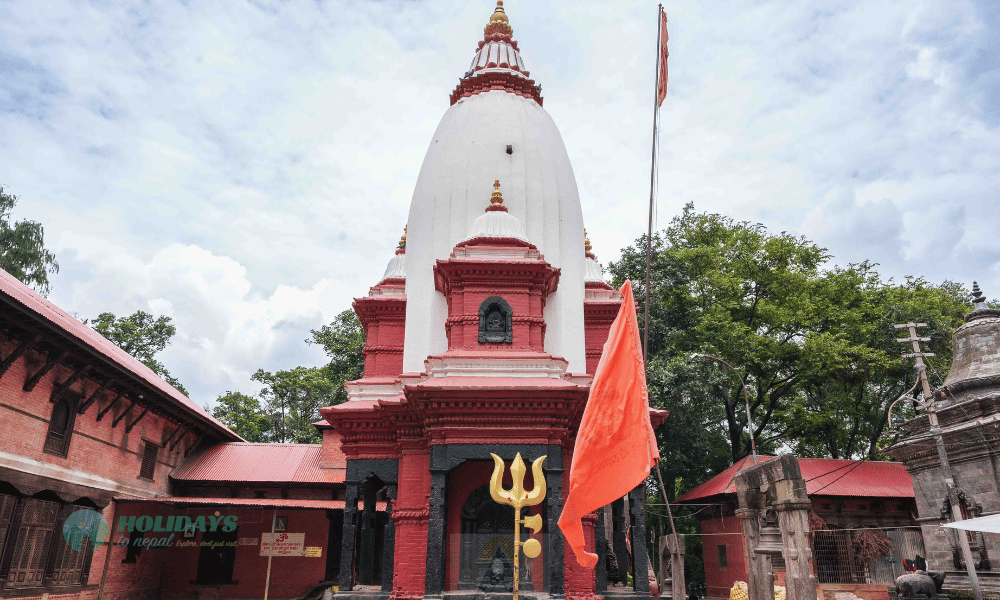
The Gorakhnath Temple can be reached by walking up the stone stairs directly opposite the Pashupatinath Temple. The Gorakhnath Temple is a notable sight as you walk through the sacred grounds of Pashupatinath. Pilgrims and visitors can walk through pathways dotted with ancient trees and traditional shrines to reach the Gorakhnath Temple. The trek to this holy refuge is both a physical and symbolic excursion through the rich history and cultural fabric of the Pashupatinath region.
In answer to the Nath Yogis' desire for appropriate accommodations, the Rana Prime Ministers built an Ashram named "Siddhachala Parbat, Mrigasthali". The name translates to "Mountain of the Siddhas" and is located on the scenic plateau of Mrigasthali, where Lord Shiva formerly wandered as a deer during the Satya Yuga. The Samadhis of prominent Yogis from the recent past are housed in this sanctuary, which is located in a deep jungle filled with monkeys.
The Gorakhnath Temple is an architectural marvel that reflects Nepal's cultural and religious beauty. The temple's red and white color palette, combining earthy tones and lively hues, complements its shikhara-style structure, which resembles a tall corn cob-like spire. The architectural design and color scheme work together to create a tranquil ambience, inviting both worshippers and curious visitors to dig into the spiritual essence held within the temple's hallowed bounds. The Gorakhnath Temple, with its historical significance and natural settings, remains an important part of the spiritual mosaic within Pashupatinath's hallowed borders.
Guhyeshwari Temple
The Guhyeshwari Temple in Kathmandu, Nepal, is an important religious monument dedicated to Adi Shakti, i.e. Parvati (and Satidevi), and is said to reflect female force and power. According to Hindu mythology, the numerous body parts of Lord Shiva's wife, Sati, fell in 51 different sites on Earth when he was carrying her lifeless body. The locations where Satidevi's body parts fell are known as Shakti Peeth (Pitha). Accordingly, there are a total of fifty-one shakti peethas. The Guhyeshwari Temple is considered to be the location of Sati's knees, making it a revered Sakti Peeth.
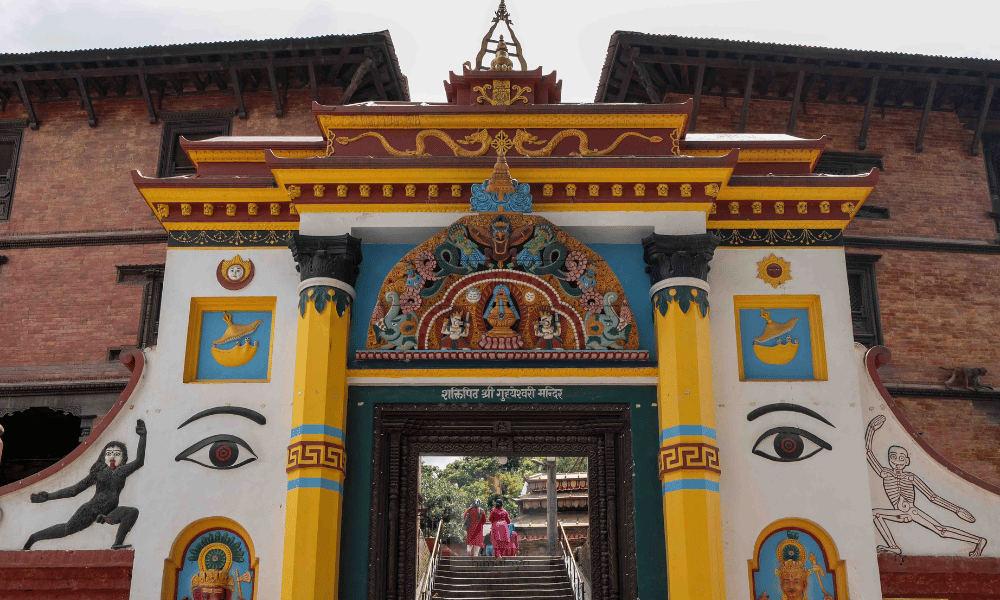
Architecturally, the Guhyeshwari Temple has a modest design that does not normally draw a lot of attention. The temple is located in the center of a courtyard and is capped with four gilded snakes that support the roof's crown. The temple's architecture is a beautiful blend of elaborate carvings, decorated silver doors, and religious motifs. Pilgrims and visitors alike are drawn to the temple's calm atmosphere, where the spiritual resonance is obvious. The temple bears witness to a rich cultural and religious legacy that has been preserved and venerated for generations.
It is a popular belief that if a couple marries in a temple and receives the goddess' blessing, they and their partner will be soulmates for the rest of their lives. That is why many people get married on the sacred ground of the temple; if one visits the temple during the month of Mangsir (between November and December), they can witness a lot of weddings taking place. Tantric practitioners also admire the Guhyeshwari Temple because, in addition to the customary puja, various tantric rituals take place inside the temple. The temple is also listed in the Kali tantra, Chandi tantra, and Shiva tantra Rahasya as one of the most essential venues to achieve tantric power.
The Guhyeshwari Temple, a revered venue for devotion and reflection, is an essential aspect of the spiritual pilgrimage experience at Pashupatinath. Devotees flock to the temple to seek the blessings of Goddess Parvati, who is revered for her heavenly grace and protection. The mythological significance of the Guhyeshwari Temple bears witness to the lasting spiritual tradition within the complex fabric of Nepal's religious environment.
Idol of Birupakshya
Birupakshya, also known as Kirateswor Mahadev, is worshiped as the sacred deity of Kathmandu's Kirat people. The Kirati monarchs of ancient Nepal erected this deity, which is believed to be an ancestor figure. It is crucial to remember that the Kirat people are diverse, which results in a wide range of beliefs and deities. Interestingly, Birupakshya is also worshiped in South India, where he is known as Virupaksha, though the claim requires verification.

On the right bank of the Bagmati River, an idol of Virupaksha can be found on the eastern side of the Pashupatinath Temple. The Virupaksha statue is partially submerged in the ground, with one half visible above and one half visible below. It is claimed that the statue is gradually arising, and that if it fully emerges, the world will be annihilated. As a result, Virupaksha is also known as Kali, as his full manifestation marks the end of the Kali Yuga.
Sandhya Aarati
Sandhya Arati, which takes place on the banks of the Bagmati River at the Pashupatinath Temple, is a mesmerizing and spiritually significant ceremony. This daily evening event, held between 6 and 7 p.m., is a devotional performance in which priests deliver prayers to Lord Shiva while accompanied by the resonating sounds of ancient instruments. The calm atmosphere of the temple complex develops into a spiritual setting filled with reverence and devotion as the sun begins to set.
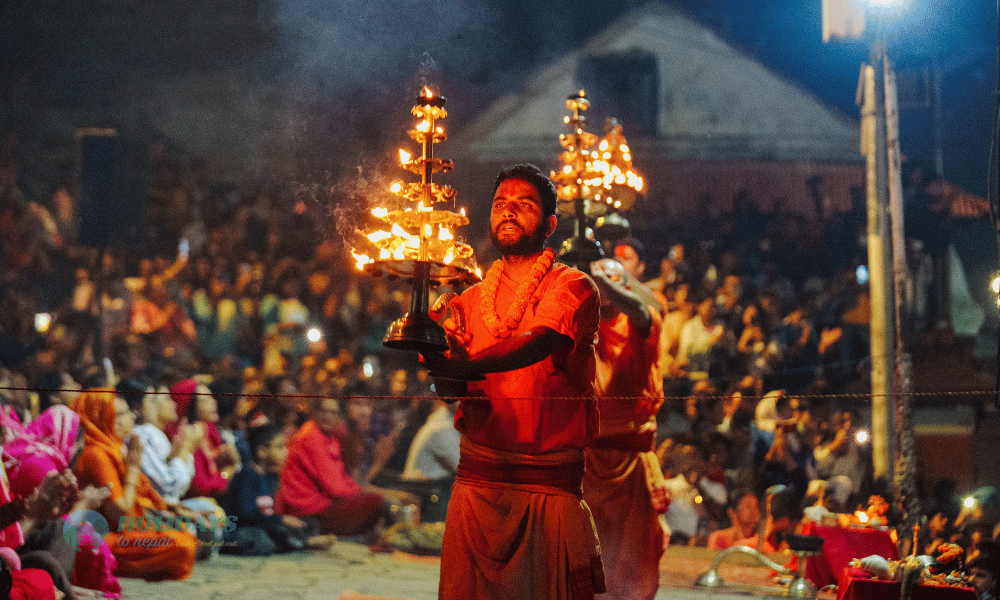
The Sandhya Arati concludes the day's worship at Pashupatinath. Pilgrims and devotees gather along the river's ghats to witness this soul-stirring event. In traditional garb, the priests perform choreographed ceremonies with three enormous lit oil lamps, incense, and other sacred offerings. In perfect rhythm and cooperation, they dip the lights four times on the bottom and circle them seven times on the top. They appear to be dancing to the beats of the Bhajan while chanting sacred chants for the Lord. The aarti concludes with a prayer for the well-being of all living souls and a thank you to God for his kindness. The rhythmic chanting of Vedic hymns and the melodic rhythms of traditional instruments combine to form a heavenly melody that resonates throughout the temple complex.
Sandhya Arati's significance extends beyond its ceremonial components. It is a time of spiritual connection and collective devotion, as worshippers participate in prayer and reflection. The flickering flames of the lamps, the floating fragrance of incense, and the calm flow of the river create an enchanting environment. Sandhya Arati is more than simply a ceremony; it's a profound experience that immerses people in the spiritual aura of Pashupatinath, cultivating a deep sense of connection with the holy.
Cremation Ghats Along Bagmati River
The cremation ghats along the sacred Bagmati River, adjacent to Pashupatinath Temple, play an important role in Hindu religious practices. Open-air cremation ceremonies are held on the river's banks, a deeply embedded tradition rooted in Hindu beliefs about the soul's journey after death. The deceased's body is placed on a pyre, and family members perform various rites with utmost reverence, according to Hindu cremation practices. Setting fire to the funeral pyre is believed to represent how short life is, and the cremation is seen as the soul's journey from the physical world to the spiritual world.
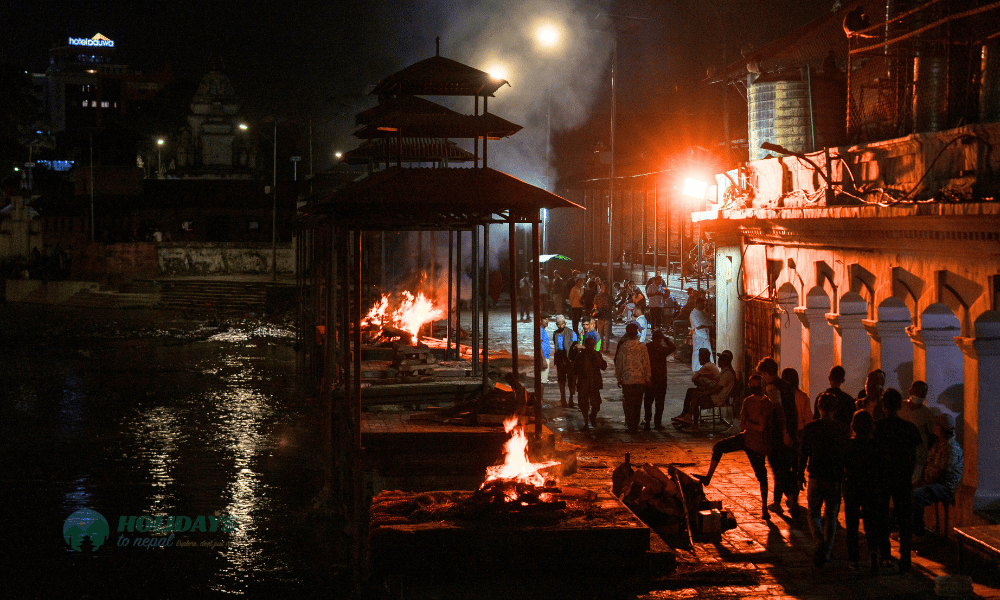
The cremation ghats are mournful places where Hindu funeral rituals are performed with a great sense of devotion. Bereaved families dress in white and follow age-old practices guided by religious scriptures. The smoke from the funeral pyres mingles with the air, producing an emotional atmosphere that highlights the cyclic nature of life and death. The Bagmati River, revered in Hinduism, serves as both a physical and spiritual route, carrying ashes and the soul of the departed towards spiritual liberation.
These cremation ghats are not only a site for the deceased's physical departure, but also a reflection of the cultural and religious tapestry that is woven into the fabric of Hinduism. The Bagmati River Bank ceremonies emphasize the brief nature of our lives and the belief in the endless cycle of reincarnation. It is a site where grief and spirituality intertwine, offering a profound glimpse into the ancient practices that lead Hindus in bidding farewell to their departed loved ones.
The Pashupatinath Viewpoint
The Pashupatinath Viewpoint provides a spectacular view of the Pashupatinath Temple and its surrounds, providing a unique viewpoint on this revered religious monument. Visitors can gaze over the huge temple complex, the rippling Bagmati River, and the lush scenery that surrounds this spiritual center from an elevated vantage point with enough seating space.
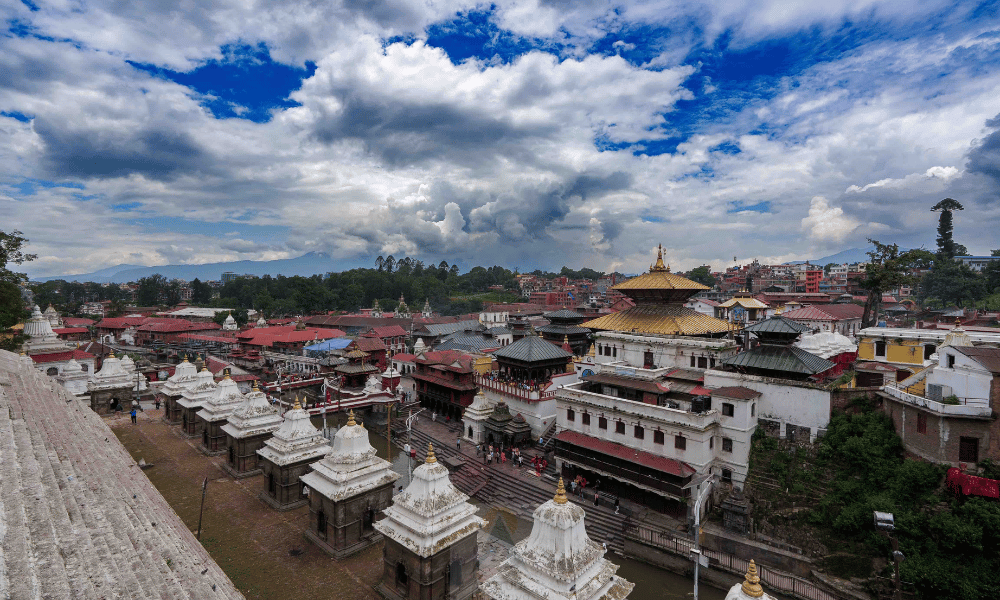
From the viewpoint, one can observe the dynamic activity within the Pashupatinath Temple grounds, such as devotees performing rituals, pilgrims circumambulating the sacred buildings, and the rhythmic flow of daily life against the majestic temple architecture. The overhead picture captures the delicate features of the pagoda-style roofs, wooden beams supporting the structures, and ornate carvings adorning the temple, providing a visual feast for those wishing to appreciate the site's artistic and cultural heritage.
Beyond the temple, the Pashupatinath Viewpoint offers a tranquil view of the Bagmati River, which is lined with cremation ghats. The meandering river, surrounded by rich flora, adds to the peaceful atmosphere, allowing visitors to reflect. The viewpoint transforms into a shelter for anyone seeking a moment of self-reflection providing a calm retreat from which to absorb the spiritual energy that permeates the entire Pashupatinath area.
The Religious Market
The religious market that surrounds the Pashupatinath Temple is a vibrant extension of the spiritual trip. Visitors passing through its tight passageways will come across an array of offerings ranging from carefully crafted Hindu deity figures to aromatic incense and vivid prayer beads. With garlands and traditional fabrics enhancing the displays, each stall radiates cultural richness, offering an immersive experience that connects with the temple's hallowed atmosphere. Pilgrims and visitors alike explore these bright stands in search of not just religious artifacts but also a tangible connection to the cultural heritage embedded in each item.

The sacred market is more than just a business venue; it fosters a sense of community among devotees who share a devotion for Lord Shiva. The air is filled with the faint buzz of hymns and prayers, forming a pleasant backdrop to the pilgrimage experience. The rich tapestry of devotees and searchers converges inside this vibrant marketplace, generating connections and exchanges that transcend mere commercial transactions, capturing the essence of shared devotion.
The religious market, which is an essential component of the Pashupatinath pilgrimage, symbolizes the diverse aspect of this sacred location. It offers a sensory trip through Nepal's cultural vitality, not simply commodities, but also an engaging exploration of the spiritual and communal components that define the larger pilgrimage experience around the revered Pashupatinath Temple.
Also Read: 12 Must Visit Hindu Temples In Nepal
Major Festivals
Pashupatinath Temple hosts a number of festivals throughout the year, making it a hub for religious festivals hosted by different communities of people in Nepal. Some of the major festivals celebrated in this sacred temple grounds are as follows:
Shivaratri
Shivaratri, or the Great Night of Lord Shiva, is a heavenly event that takes place with unparalleled glory at Pashupatinath Temple. Thousands of devotees dressed in traditional clothing flock to the temple complex to celebrate this auspicious event. Shivaratri is a Hindu festival that honors Lord Shiva and Goddess Parvati's marriage and the day when Shiva performs his holy dance, the Tandava, which supports the cosmos.
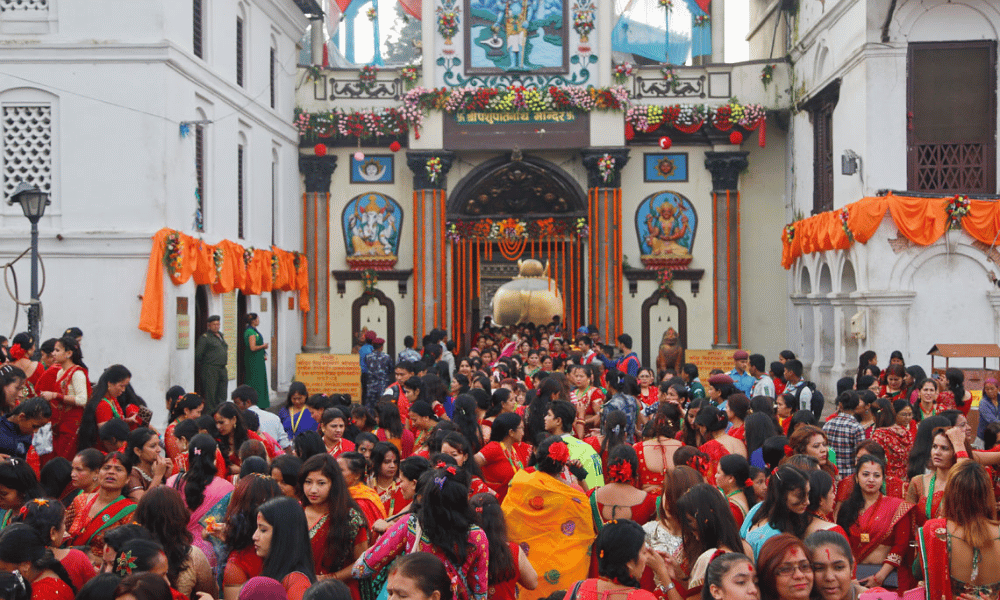
During Shivaratri, the Pashupatinath Temple becomes the focal point of religious observances. People from all around the world visit Pashupatinath Temple on this auspicious occasion to pay their respect to Lord Shiva. Pilgrims embark on a spiritual journey, praying, meditating, and performing rituals throughout the night. The glow of oil lamps and the aroma of incense fill the temple precincts, creating an ethereal environment that resonates with the deep spirituality of the occasion. On this holiest of nights, the Bagmati River, which flows alongside the temple, witnessed a steady stream of worshippers taking traditional dips in search of purification and divine benefits.
The Maha Shivaratri procession is the highlight of Shivaratri at Pashupatinath. A colorful parade of Shadus from different parts of the world, particularly from India, winds its way around the temple complex, with many of them bearing symbolic emblems of Lord Shiva such as lingams and tridents. The sounds of chants, bhajans, and the rhythmic beats of traditional instruments fill the air. The conclusion of the night's festivities is the offering of prayers to Lord Shiva, seeking his blessings for spiritual enlightenment and divine grace as dawn comes. Shivaratri at Pashupatinath is more than just a religious event; it is a cultural spectacle that brings believers together in a collective act of devotion, establishing a profound link between the earthly and the holy.
Learn More: Maha Shivaratri Festival In Nepal
Teej Festival
Teej, a colorful and cheerful festival celebrated mostly by Hindu women, comes to life in an extravagant display of devotion and cultural spirit at Kathmandu's Pashupatinath Temple. Teej, a three-day festival dedicated to the worship of Lord Shiva and Goddess Parvati, is celebrated with tremendous passion, particularly by married and unmarried women. The temple complex transforms into a dynamic hub where traditional customs, brilliant colors, and heartfelt prayers converge to honor the sacred tie of marital joy and feminine strength.\
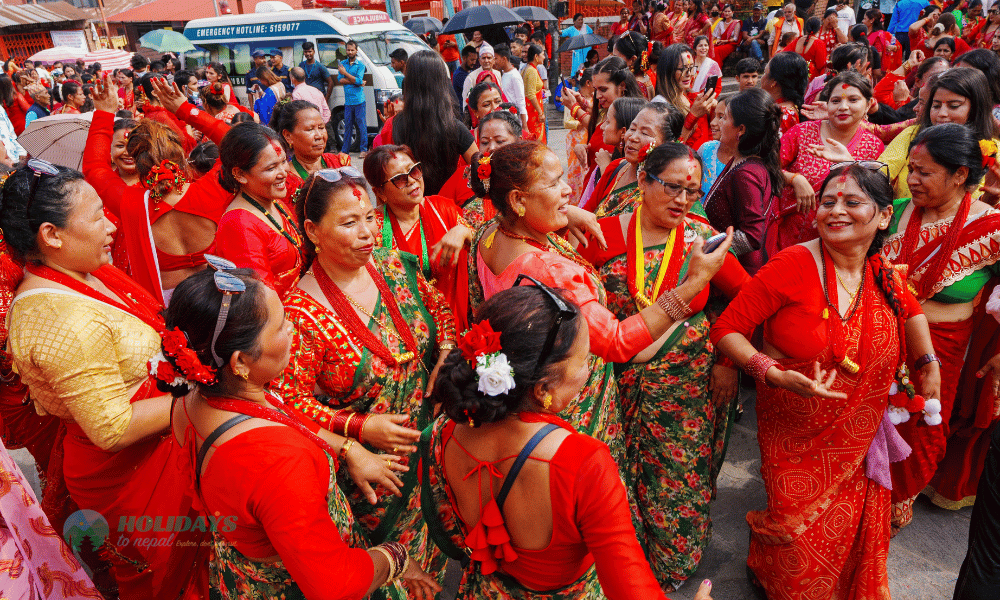
During Teej, ladies dressed in vibrant red clothes, symbol of auspiciousness and marital happiness, gather at Pashupatinath to pray for their husbands' well-being. The celebrations involve singing traditional Teej songs, known as "Teej Geet," and participating in passionate dances that highlight Nepal's cultural richness. Married ladies fast during the day, breaking their fast only after praying to the Shiva Lingam in the temple, whilst unmarried women seek Lord Shiva's blessings for an ideal life partner.
The Pashupatinath Temple transforms into a lively backdrop for these festivals, beating with the sounds of traditional music, the aroma of incense, and the joyful laughter of ladies involved in the festivity. The Bagmati River, which flows alongside the temple, witnesses traditions in which women, after finishing their prayers, release handmade floral floats, or "jhulas", into the river as a mark of their devotion. Teej at Pashupatinath is not only a religious festival, but also a cultural spectacle that celebrates Nepalese women's determination, faith, and festive spirit, generating an environment of unity and joy within the temple's sacred grounds.
Learn More: Haritalika Teej Festival In Nepal
Bala Chaturdashi
Bala Chaturdashi is a significant and emotional celebration celebrated at the Pashupatinath Temple on the fourteenth day of the dark fortnight in the Hindu month of Kartik. This festival, also known as Deepawali or Narak Chaturdashi, occupies a particular place in the hearts of devotees who gather at the temple to participate in ceremonies honoring deceased loved ones. The day is spent burning oil lamps and praying for the souls of the deceased.
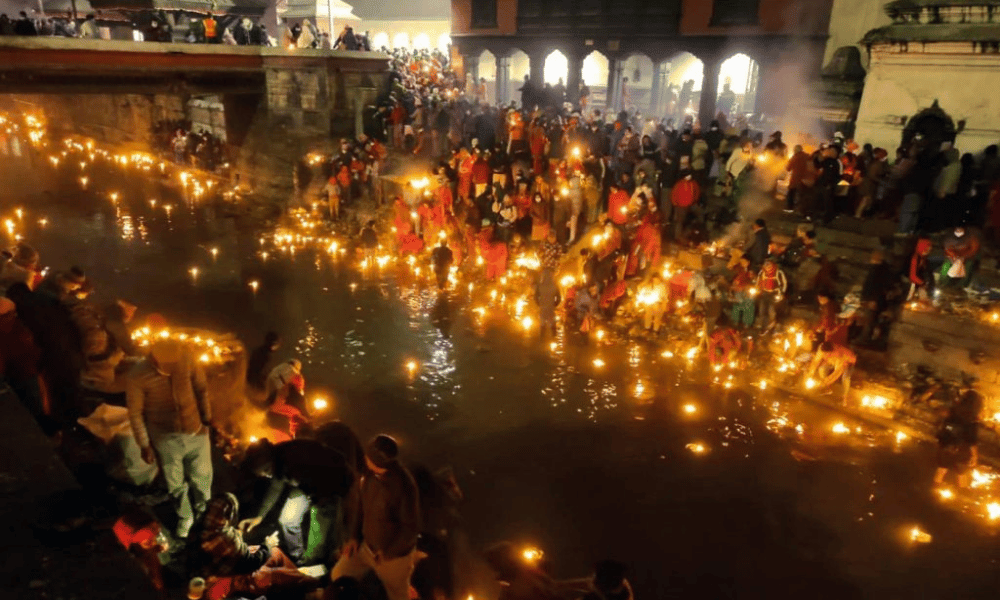
On Bala Chaturdashi, worshippers take a ritualistic journey around the Pashupatinath Temple complex, lighting oil lamps as they go. These lamps, known as "bala," are lighted in tribute of deceased family members, and their flickering flames represent the triumph of light over darkness. The Bagmati River, which flows alongside the temple, sees little oil lamps float when devotees release them into the river as an offering to their ancestors.
The temple complex changes into a sea of lights when night falls, creating a quiet and contemplative atmosphere. A profound spiritual environment is created by the continuous chanting of prayers, the soothing glow of innumerable lamps, and the traditional circumambulation. Bala Chaturdashi is a severe depiction of the continuing connection between the living and the departed, as well as a festival of memory. During this event, the rituals performed at Pashupatinath highlight the cultural richness and profound spirituality ingrained in Nepalese traditions, providing peace and insight to people wishing to honor their ancestors.
Also Read: Nepal Festival Calendar
Pashupatinath Temple Daily Rituals
Pashupatinath is the living pilgrimage center of Nepal, and has a diverse array of deep experiences to give. The spiritual ambience is amplified in the evening with the start of the aarti ceremony. The following are the everyday ceremonies that take place around the temple:
04:00 am: West gate opens for visitors.
09:30 am: Pujaris arrive, open the 4 doors of the main temple and the bath and cleaning process of lord’s idol begins.
09:30 am: Conducting special puja till 11:30 am.
12:00 pm: Offering Baal Bhog to the lord till 12:30 pm.
01:30 pm: Lord shiva is presented with Mulbhog.
02:15 pm: Prayers time end and all 4 doors of the main temple closes.
06:45 pm: Temple door reopens and the evening Aarati and Jal Avishekh at the main Pashupati Temple begins.
07:00 pm onward: Daily Bagmati Ganga Aarti begins. Many people including youngsters attend this event.
08:00 pm: All Doors are closed.
Pashupatinath Temple Pujas Cost
Apart from the standard puja, one can book separate pujas in the Pashupatinath Temple, these are the varieties and their costs:
|
Puja Name |
Cost (NPR) |
Cost (INR) |
|
Panchamrit Puja |
2,100 |
1,313 |
|
Panchamrit puja with Baal bhog |
3,100 |
1,938 |
|
Panchamrit puja with Baalbhog and Rudrabhisek |
7,500 |
4,688 |
|
Panchamrit puja with Laghu Rudrabhisek and Purabhog |
15,100 |
9,438 |
|
Panchamrit puja with Rudrabhisek, Purabhog, Sawalakh (1.25 lakhs) batti aarti |
35,000 |
21,875 |
|
Panchamrit puja with Laghu Rudrabhisek, Purabhog, Hawan and Sawalakh (1.25 lakhs) batti aarti |
65,000 |
40,625 |
|
Nitya Bhog and day-long puja |
1,71,000 |
1,06,875 |
|
Ek Diwasiya Maharudri |
3,21,000 |
2,00,625 |
|
Ekadash Diwasiya Maharudri |
8,00,001 |
5,00,001 |
|
Ekadash Diwasiya Atirudri |
25,00,000 |
15,62,500 |
Best Time To Visit Pashupatinath Temple
The best time to visit Pashupatinath Temple largely depends on personal preferences and the type of experience one seeks. However, considering various factors, certain times may be more favorable for a fulfilling and comfortable visit.
Mild Weather Months (September to November, March to May): These months offer a pleasant climate, with temperatures ranging from mild to warm. This makes exploring the temple complex and its surroundings more comfortable. Additionally, during the festival of Maha Shivaratri (usually in February or March), the temple comes alive with vibrant celebrations, attracting devotees and visitors from around the world.
Early Morning or Late Afternoon: To experience the temple in a serene atmosphere with fewer crowds, consider visiting during the early morning or late afternoon. The soft sunlight during these times enhances the architectural beauty of the temple and provides a peaceful setting for prayer and contemplation.
Post-Kailash Pilgrimage: Pashupatinath Temple holds immense significance for Hindu pilgrims, and many choose to include it as part of their spiritual journey after visiting Mount Kailash. The temple is believed to be a sacred abode of Lord Shiva, and paying homage here can serve as a meaningful conclusion to Kailash Mansarovar Yatra.
Avoiding Monsoon Season (June to August): Monsoon season brings heavy rainfall to the region, which may result in slippery pathways and difficult travel conditions. The river levels can rise, affecting the accessibility of certain areas. It's advisable to avoid this period for a more comfortable and safe visit.
Cultural Festivals: If you wish to witness the rich cultural and religious celebrations, planning your visit around major Hindu festivals such as Teej or Bala Chaturdashi can provide a unique and immersive experience.
Off-Peak Hours: To avoid large crowds, plan your visit during weekdays and during the off-peak hours. Early mornings are generally quieter, allowing for a more contemplative experience.
Remember to check the local calendar for any special events, festivals, or renovations that might affect your visit. Overall, selecting a time that aligns with your preferences and the atmosphere you seek will contribute to a memorable and fulfilling visit to Pashupatinath Temple.
Also Read: Muktinath Temple | Manakamana Temple
How to reach Pashupatinath Temple
Pashupatinath, only 5 km from Kathmandu Durbar Square and 2.5 km from Tribhuvan International Airport, is a spiritual pilgrimage through Nepal's heart. Learning about how to reach Pashupatinath temple from inside and outside Kathmandu might help one significantly during their visit.
From Inside Kathmandu:
Pashupatinath Temple is easily accessible from many parts of Kathmandu, making it a pilgrimage site for both locals and visitors. Hiring a cab or using ride-sharing services is one of the most common ways to go to Pashupatinath, since they provide a simple and direct travel to the temple complex. Additionally, public buses and micro-vans run along routes near Pashupatinath, giving visitors a more cost-effective transportation alternative. Once at the temple, pilgrims can explore the large complex on foot, soaking in the spiritual ambience and visiting the different shrines and ghats along the Bagmati River.
From Outside Kathmandu:
The main gateway for individuals arriving from outside Kathmandu is the Tribhuvan International Airport. Visitors can reach Pashupatinath Temple by taxi, pre-arranged airport shuttles, or ride-sharing services from the airport. Depending on traffic, the journey from the airport takes about 20-30 minutes. Long-distance buses and private tour operators also provide transportation from major cities outside of Kathmandu. These services make it easier for pilgrims and tourists to reach the sacred location while also enjoying Nepal's gorgeous scenery. Reaching Pashupatinath from outside Kathmandu is a seamless and culturally enriching experience, laying the groundwork for a meaningful visit to this venerated Hindu temple.
Things To Remember
Before visiting Pashupatinath Temple, there are several essential considerations to ensure a respectful and enjoyable experience:
Dress Modestly:
Wear modest clothing out of respect for the sacred nature of the temple. Both men and women should cover their shoulders and knees.
Remove Footwear:
Before entering the temple premises, remove your footwear. It's a customary practice to walk barefoot within the temple complex. One can store their shoes in a secure place opposite to the entrance gate of the Pashupatinath temple area.
Photography Restrictions:
Respect photography restrictions. Some areas might be off-limits for photography, particularly during religious ceremonies. Always seek permission before taking pictures of people.
Silence and Respect:
Maintain a quiet and respectful demeanor within the temple. It is a place of worship, and visitors are expected to conduct themselves accordingly.
Circumambulation Direction:
When walking around the temple or certain sacred structures, always move in a clockwise direction as a sign of respect.
Participate Respectfully:
If there are ongoing ceremonies or rituals, feel free to observe, but avoid disrupting the proceedings. Participation is welcome, but ensure it aligns with the reverence of the moment.
Know the Rituals:
Familiarize yourself with basic Hindu rituals to better understand and appreciate the significance of what you witness during your visit.
Be Mindful of Cremation Ghats:
If visiting the cremation ghats along the Bagmati River, maintain a respectful distance. These areas are sacred and hold great emotional significance.
Respect Monks and Sadhus:
If you encounter monks or sadhus (Hindu holy men), approach them with respect. Seek permission before taking photographs and engage in conversations with sensitivity.
Check Opening Hours:
Check the temple's operating hours before visiting, as the temple remains closed at certain periods of the day.
By keeping these considerations in mind, visitors can contribute to the sanctity of Pashupatinath Temple and ensure a culturally enriching and respectful experience.
Frequently Asked Questions (FAQs)
Here are some Frequently Asked Questions about Pashupatinath Temple:
Where is Pashupatinath Temple located?
Pashupatinath Temple is located in Kathmandu, the capital city of Nepal, on the banks of the Bagmati River.
What is the significance of Pashupatinath Temple?
Pashupatinath is considered one of the holiest shrines for Hindus and is dedicated to Lord Shiva. It holds immense cultural, spiritual, and historical significance.
Can non-Hindus visit Pashupatinath Temple?
Yes, non-Hindus are allowed to visit most parts of the temple complex, except for the main temple itself. Respectful behavior is expected from all visitors.
What is the best time to visit Pashupatinath Temple?
The temple can be visited throughout the year, but the months of September to November and March to May, with milder temperatures, are often considered more comfortable for tourists.
Are there any clothing restrictions for visitors?
There are no specific restrictions for clothing but visitors are expected to dress modestly. Both men and women should cover their shoulders and knees. It's customary to remove footwear before entering the temple premises.
Can I take photographs inside the temple complex?
Photography regulations vary, and some areas might have restrictions, especially during religious ceremonies. Always seek permission before taking pictures of people.
What are the main festivals celebrated at Pashupatinath Temple?
Maha Shivaratri is the most significant festival celebrated at Pashupatinath. Teej and Bala Chaturdashi are also observed with enthusiasm.
Is there an entrance fee to visit Pashupatinath Temple?
Yes, there is an entrance fee for foreign tourists. The fee contributes to the maintenance and preservation of the temple complex.
What are the opening hours of Pashupatinath Temple?
The temple opens early in the morning at 4 am and closes in the evening at 8 pm. It's advisable to check the specific opening hours as they may vary.
Can visitors witness cremation ceremonies along the Bagmati River?
Yes, visitors can observe cremation ceremonies at the ghats along the Bagmati River. It's important to maintain a respectful distance and behavior during such solemn occasions.

